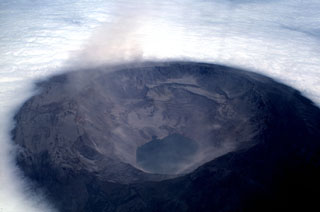Report on Fernandina (Ecuador) — 28 February-5 March 2024
Smithsonian Institution / US Geological Survey
Weekly Volcanic Activity Report, 28 February-5 March 2024
Managing Editor: Sally Sennert.
Please cite this report as:
Global Volcanism Program, 2024. Report on Fernandina (Ecuador) (Sennert, S, ed.). Weekly Volcanic Activity Report, 28 February-5 March 2024. Smithsonian Institution and US Geological Survey.
Fernandina
Ecuador
0.37°S, 91.55°W; summit elev. 1476 m
All times are local (unless otherwise noted)
IG-EPN reported that an eruption at Fernandina began around 2350 on 2 March from a circumferential fissure on the upper SE flank. The fissure possibly propagated 3-5 km and produced a gas emission with low ash content that rose 2-3 km above the summit and drifted W, NNW, and SSE. The emission was detected in satellite data and the fissure was confirmed by pictures shared on social media and reports from Parque Nacional Galápagos. The emissions were intense until about 0400 on 3 March before decreasing. More than 1,000 thermal anomalies were identified in satellite images during 0044-0135 corresponding to multiple lava flows descending the SE flank. Sulfur dioxide emissions were about 46,460 tons per day (t/d) at 1327 on 3 March, based on satellite data. During 3-4 March gas plumes with low to no ash content continued to be identified in satellite images, drifting WSW. Hundreds of thermal anomalies were detected in satellite data with some of the intensities of the anomalies being characterized as high, very high, and extreme. Sulfur dioxide emissions had decreased to about 24,000 t/d at 1327 on 4 March, based on satellite data. Observations by park rangers during 4-5 March indicated that activity had decreased and the lava flows had only advanced slightly. Satellite data indicated that sulfur dioxide emissions continued to decline and were about 2,228 t/d at 1247 on 5 March. Gas plumes rose 370-970 m above the summit and drifted WSW. Hundreds of thermal anomalies continued to be detected during 5-6 March with a few being characterized as high to very high. The lava flows had traveled as far as 7.9 km based on satellite data and maps.
Geological Summary. Fernandina, the most active of Galápagos volcanoes and the one closest to the Galápagos mantle plume, is a basaltic shield volcano with a deep 5 x 6.5 km summit caldera. The volcano displays the classic "overturned soup bowl" profile of Galápagos shield volcanoes. Its caldera is elongated in a NW-SE direction and formed during several episodes of collapse. Circumferential fissures surround the caldera and were instrumental in growth of the volcano. Reporting has been poor in this uninhabited western end of the archipelago, and even a 1981 eruption was not witnessed at the time. In 1968 the caldera floor dropped 350 m following a major explosive eruption. Subsequent eruptions, mostly from vents located on or near the caldera boundary faults, have produced lava flows inside the caldera as well as those in 1995 that reached the coast from a SW-flank vent. Collapse of a nearly 1 km3 section of the east caldera wall during an eruption in 1988 produced a debris-avalanche deposit that covered much of the caldera floor and absorbed the caldera lake.
Sources: Instituto Geofísico-Escuela Politécnica Nacional (IG-EPN), Parque Nacional Galápagos

